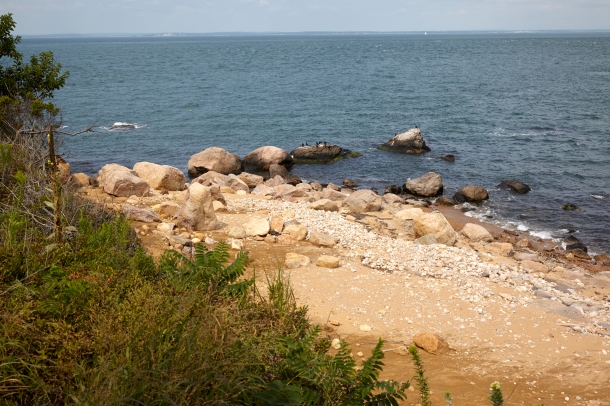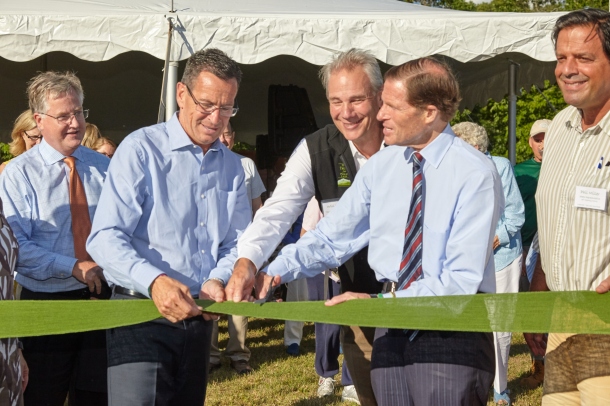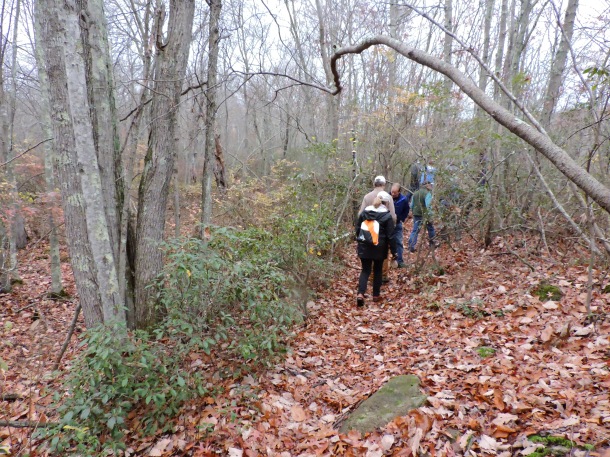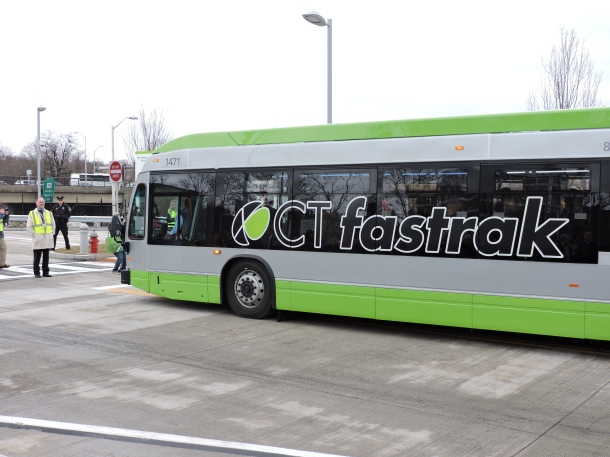Together we did great things to protect Connecticut’s land, air, and water and Long Island Sound in 2015!
Here are a few highlights:
- We’ve taken big steps to solve the nitrogen pollution that chokes the Sound and the bacterial pollution that plagues its beaches, including a lawsuit in Westchester and a new tool to show how clean or dirty your local beach is.
- We warned the federal government that if necessary, we would sue to protect Plum Island’s endangered wildlife.
- Towns around Connecticut are rallying to save healthy trees from utility cutting with our toolkit and community meetings.
- We’re taking down two dams in Connecticut so fish can get upstream—and local residents can be safe from flooding.
- One big land protection battle ended in victory as The Preserve was permanently conserved, and others began as we contribute our legal expertise to the fight to save the Oswegatchie Hills and work to protect drinking water lands in West Hartford.
Read on to learn more about what we did each season, and to get a taste of what we expect in the coming year!
WINTER
We opened 2015 with two bold moves on the national stage.
Protecting Plum Island’s wildlife and habitats
One year ago, we announced our intent to sue the federal government over violations of the Endangered Species Act. CFE/Save the Sound issued a notice letter to the Department of Homeland Security and the General Services Administration, alleging that the agencies have failed to protect endangered and threatened species while pursuing a public sale of the federally-owned island. Throughout the year, we’ve continued to work with our other partners in the Preserve Plum Island Coalition and Connecticut’s and New York’s federal delegation to push for a conservation solution.

Solving the nitrogen pollution that chokes the Sound
Also in January 2015, we filed a petition with the US EPA, Connecticut, New York, and other states that drain to Long Island Sound demanding a new comprehensive program to address the nutrient pollution that is choking Long Island Sound. We expect a public response and strategy from EPA any day now.
Fighting stormwater pollution in Connecticut
When the Connecticut Department of Energy and Environmental Protection issued a stormwater permit last winter that was too weak to protect water quality, we intervened as legal parties to require DEEP to strengthen environmental protections and comply with the Clean Water Act. We also fought back against municipalities who were trying to weaken the permit. We anticipate the revised permit in the new year, with stronger protections that will make much-needed progress in our fight against stormwater pollution.
Advocating in the Connecticut legislative session
2015 was a budget year in Connecticut, so we fought hard to defend critical funding for environmental priorities like the Clean Water Fund and transportation services, and to make sure bills that would weaken environmental protections didn’t make it to the finish line. Our new Connecticut Electric Vehicle Coalition brought together environmentalists and auto dealers, and DEEP has since created a rebate for EV buyers and leasers—a good move that we hope to build on! Utility companies brought out the big guns to fight a proposal to make solar power more available to residents who rent or have shady roofs, but we’ll keep pushing for a fair arrangement. Stay tuned for our 2016 Connecticut legislative agenda, coming soon.

SPRING
Saving the Preserve—for good!
After a long battle and 10 years of legal intervention and community outreach work by CFE, the 1,000-acre coastal forest in Old Saybrook, Westbrook, and Essex known as “The Preserve” was permanently preserved for future generations with a deal closed in May. Later in the summer, over 200 people who’d fought for the land joined in a ribbon-cutting ceremony to formally open the newly-conserved property.

Fighting for Oswegatchie Hills
But in the world of protecting our forests and wetlands, there’s little time to rest on our laurels! In the spring we joined local groups in the fight to protect the Oswegatchie Hills, prime riverfront land in East Lyme endangered by reckless development plans. The Hills provide some of the best hiking in the area and filter water that flows to the Niantic River. The proposal would largely replace the top of a hill with 36 acres of paved and hard surfaces and 1,767 parking spaces, destroying the Hills and polluting the Niantic River estuary. We’re leading the legal challenge to this environmentally devastating proposal and are fighting the developers in the East Lyme Zoning Commission and the Connecticut Superior Court.

Big moves in transit
2015 was a seriously big year for transit and transportation in Connecticut! The long-awaited CTfastrak opened in March to enthusiastic ridership and will be expanding eastward toward UConn. We joined federal legislators and state leaders at a Stand Up 4 Transportation rally on April 9 as part of a national call for long-term, reliable federal funding for our roads, bridges, and rails. Governor Malloy presented an ambitious 30-year transportation vision and 5-year ramp-up and moved for a lockbox to make sure transportation funding is used only for transportation projects. We expect that battle, a topic at our 4th annual Transportation Funding Forum in December, to continue this year.

Protecting healthy trees in your neighborhood
As Connecticut’s electric utilities continue to unnecessarily cut healthy trees, we continue to advocate for a sane approach that manages risky trees and protects the healthy trees that beautify our neighborhoods, cool our sidewalks, and purify our air. Forums that we hosted with our allies in Farmington and Stamford attracted members of the public to learn about residents’ rights, and we’re meeting with local officials around the state to help strengthen municipal tree ordinances. Check out our guide to protecting your trees and find your local tree warden.

SUMMER
Tracking data on the Sound’s beaches
Our new online tool Sound Health Explorer, launched in July, shows historical data on bacterial pollution levels at every beach around Long Island Sound. The interactive map and data will increase understanding of water quality and empower everyone who loves the Sound to help activate local and regional solutions to stop pollution. This year we’ll expand the Sound Health Explorer to include information on low oxygen conditions around the Sound.

Monitoring bacterial pollution in the western Sound
In 2015, we significantly expanded our water quality testing area to include all Westchester County’s shoreline communities and Greenwich, CT to gather current data, too. With the help of 24 trained volunteers, we collected about 400 water samples at 52 sites, testing each sample for bacteria that indicates fecal contamination and scoring each sample based on New York and Connecticut safe swimming criteria. We use the results to identify and help correct sources of sewage pollution and drive investment in wastewater infrastructure repairs to stop this public health hazard. Read our findings here.

Making a healthier Sunken Meadow
Our biggest on-the-ground project yet kicked off last summer with outdoors education and a massive volunteer planting. The effort brings together federal funding, state parks staff, engineers, volunteers, and more to improve marsh habitat and water quality at Long Island’s Sunken Meadow State Park. When complete, not only will wildlife have the chance to thrive, but the park’s streams and beaches will be cleaner and the park will be more resilient to future storms. Lots more to do, so stay tuned for updates this year!
Watching over the West River
In the greater New Haven area, we focused on community approaches to healthy water. Save the Sound led the development of a West River Watershed Management Plan to identify the needs of this urban river. And it was still beautiful late-summer when volunteers turned out to help us put some of the goals into practice, too, building rain gardens along Edgewood Avenue to capture and filter stormwater. You can see photos here!
FALL
Taking legal action to stop water pollution in Westchester
Manifold and disturbing: that’s the best way to describe the environmental and public health impacts of spilled sewage on our communities. For decades the sewer lines that run under Westchester streets and lawns have been leaking raw sewage into our waterways, causing low oxygen, high bacteria levels, and long-term harm to the Sound. So this fall we took legal action against Westchester County and 11 towns for Clean Water Act violations. Save the Sound believes that bringing the lawsuit is the best action we can take to get all the responsible parties to the table to reach a comprehensive, long term solution to this decades-old infrastructure problem, improving water quality and quality of life for residents. Read about our suit in more detail.

Free-flowing rivers once again
Dams are bad news for fish. After years of building fish ladders and other methods to help migrating fish get past dams to their upstream spawning grounds, we took a big step in the fall: actually removed outdated dams at Pond Lily on the New Haven-Woodbridge border and at Hyde Pond in Mystic. And these projects have another benefit: they’ll protect nearby residents and businesses from flooding by eliminating the risk of dam failure. Keep an ear to the ground this spring to learn how you can help stabilize and beautify the rivers’ new banks by planting native shrubs and flowers!
Thinking globally and acting locally on our beaches
There’s no better way to say goodbye to the summer than showing your favorite beach some litter-picking love while knowing that thousands upon thousands of people worldwide are doing the same! For this year’s International Coastal Cleanup, which Save the Sound has been coordinating in Connecticut for two decades, over 1,500 volunteers gathered up more than three tons of trash from our beaches. And numbers are still coming in!
Generous members supporting our work
Our members gathered at the Beardsley Zoo in Bridgeport, CT, in September to celebrate our 2015 annual meeting with an inspiring keynote address on sustainable communities from Carolyn Vary of Jonathan Rose companies and awards to activists of all ages. We were excited when, over the course of the year, several donors chose to add extra value to their gifts by creating opportunities for leverage. We are grateful for their exemplary charitable spirit in the areas of multi-year gifts, building legal capacity, saving Plum Island, and support to enhance Save the Sound’s Long Island outreach, communications, and membership program. We are honored by your generosity!
Stamford 2030 pushing for innovation
Stamford 2030, formed in partnership with the Business Council of Fairfield County and part of a national network of sustainability districts, continued to grow this year, adding staff and holding its first annual Change Makers award ceremony in October. In addition, it was one of only eight projects nationwide funded by the 2015 Partners for Places competitive grants—a collaboration between the Funders’ Network for Smart Growth and Livable Communities, and the Urban Sustainability Directors Network.

A vision for the climate
As we celebrated Thanksgiving, CFE communications staffer Sarah Ganong was in Paris at the UN climate talks. We’re incredibly grateful to Sarah for volunteering her time and travel to observe and report on these historic talks! Back in Connecticut we’ll be fighting to keep that momentum going through our membership on the Governor’s Council on Climate Change, local grassroots coalitions, and pollution-cutting legislation.
Protecting drinking water lands from a gas pipeline
At the end of the year, we began working with organizations from around the state to stop a Tennessee-based power company’s plans to build a gas pipeline across protected lands in West Hartford. The lands have been set aside to protect drinking water for hundreds of thousands of people in Connecticut and should not be endangered—and that’s why we formally intervened in federal proceedings. While there are many alternatives to a natural gas pipeline, there are no alternatives to clean drinking water.
We have big plans for 2016! Watch our blog and join our email network to hear the latest news!
